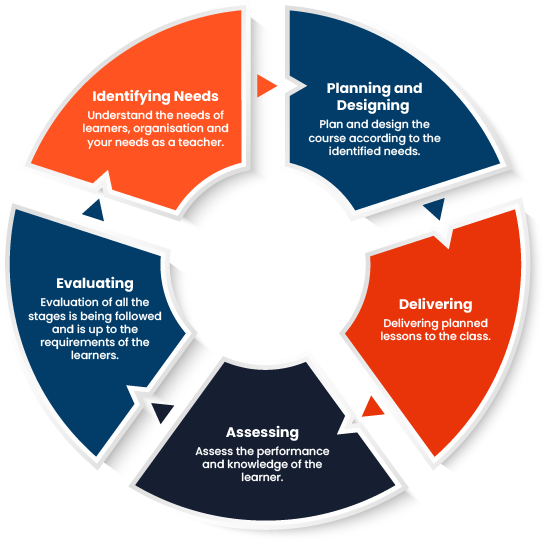Every step of teaching is a dynamic process, from determining the needs of the learners and creating learning objectives to facilitating and carrying out assessments to fosters a reflective practice that can lead to continuous improvement in teaching effectiveness. Understanding the teaching cycle approaches to teaching significantly improve learner engagement and performance.
In this blog we will examine how the teaching cycle functions and how you may apply it to your teaching practices.
The 5 Stages of Teaching Cycle

This teaching cycle consists of five distinct stages:
- Identifying Needs
- Planning and Designing
- Delivering
- Assessing
- Evaluating
Each stage builds on the previous one to create a smooth learning process that maximises learner engagement and understanding.
WIdentifying Needs
In the first stage of the teaching cycle, it is necessary to understand the needs of learners, the organisation and yourself as a teacher. This stage involves identifying the learners’ backgrounds, goals, and individual requirements through diagnostic assessments and learning plans. For example, understanding a student’s preference for visual aids can help you tailor your teaching methods.Teachers must first concentrate on the needs of the learners and identify the preferred method of teaching and resources.
Within this stage, a teacher will:
- Find out the backgrounds, motivation for the course, goals and aspirations of learners.
- Conduct initial or diagnostic assessment of your learner.
- Identify individual learning styles, preferences and needs.
- Develop individual learning plans.
- Identify the needs of the organisation.
- Ensures teaching style that help meeting learners their set goals and progression in learning.
Planning and Design
The second step, once the learner’s needs are identified, is planning and designing. Planning involves catering learner needs while prapering scheme of work, lessons plans and other documentations lies within the delivery of qualification. This also includes eensuring the environment inclusive and safe, revieing the GLH to ensure time allocationfor delivery and finally learners demographics to consider their needs. Develop simple and clear learning objectives making a road map for the entire teaching process. Next, design the appropriate and relative teaching material and resources that align with the learning objectives and suit different the teaching methods and styles.
In the planning and designing phase, a teacher will:
- Identify the teaching environment, assess course length and learner demographics
- Ensure the environment is safe and inclusive
- Devise Schemes of Work and detailed Lesson Plans tailored to meet programme criteria
- Streamline teaching resources and learning material
- Review the guided learning hours (GLH)
- Varying Teaching methods and styles
Delivering and Faciliting Learning
It is an active stage where teachers effectively deliver planned lessons using the material they developed. Teachers facilitates learneing using a variety of approaches, activities and resources to achieve desired outcomes. The main focus is on learners motivation, engagement and inspiration. Teacher.
Teachers should ensure delivery of sessions are interactive, engaging, and fit for purpose by using varied teaching approaches and demonstrating enthusiasm for the subject. They can further enhance engagement by using differentiated resources, delivering interesting lectures, incorporating real-life examples, organising group discussions, and including hands-on activities to meet the diverse needs of learners.
This stage involves:
- Delivering engaging lessons
- Adapt a variety of teaching methods and resources
- Monitor attendance and punctuality
- Ensure there is no knowledge gap
- Creating a positive and inclusive learning environment
- Ensuring session plans are fit for purpose and meet the diverse needs of learners
Assessing
In this stage, trainers assess the learners’ understanding, progress, and overall achievement. Various methods such as verbal questions, written tests, projects, presentations, and group work can be used to check learners’ knowledge and skills.
- Formative assessments occur throughout the course, providing ongoing feedback to help learners identify areas for improvement and allowing teachers to adjust their teaching strategies.
- Summative assessments take place at the end of the course to evaluate overall learning and compare results against set standards or benchmarks.
Explore more about the Concept and Principles of Effective Assessment in Education
Teachers make sure assessments are transparent and fair, meeting the learning objectives as outlined by the awarding bodies to make accurate decisions.
The teacher will be required to:
- Finalise and implement appropriate assessment methods
- Conduct detailed formative assessments
- Perform summative assessments
- Perform detailed assessment
- Determine whether learners have achieved their learning objective
- Provide constructive and actionable feedback
- Identify and address any knowledge gap
- Ensure assessments are fair, transparent, reliable, and aligned with learning objectives
Evaluating
This is the final stage of the teaching cycle focuses on evaluating the effectiveness of the teaching and learning process. that will tell if the above-mentioned stages are all followed and are up to the requirements of the learners. It will also point out if there is room for improvement at any stage. Feedback from learners, colleagues, managers, and sometimes anonymous feedback are important in this stage, and they are gathered through tools like surveys, discussions, or peer observations.
In this method, a teacher will:
- Analyse whether the course objectives and learners’ needs have been met.
- Gather detailed feedback on teaching methods, learning materials, and assessment strategies.
- Identify areas for improvement in teaching practices and course delivery.
- Ensure teaching practices align with internal quality assurance and standardisation.
- Reflect on feedback to make informed adjustments.
- Implement necessary changes to enhance future courses and maximise learner success.
Final Thoughts
The teaching cycle is vital for effective education, guiding teacher to refine their practices and learning experiences. This cycle helps the learners increase their learning abilities. By acknowledging every stage of the teaching cycle, teachers can empower learners with skills nd knowledge needed to succeed in an ever-evolving world. The cycle is dynamic, looping back to the identifying needs stage after evaluation, ensuring continuous improvement. Over time, this process helps teacher gain confidence and familiarity with their teaching practices and foster a lifelong love of learning among their students.




